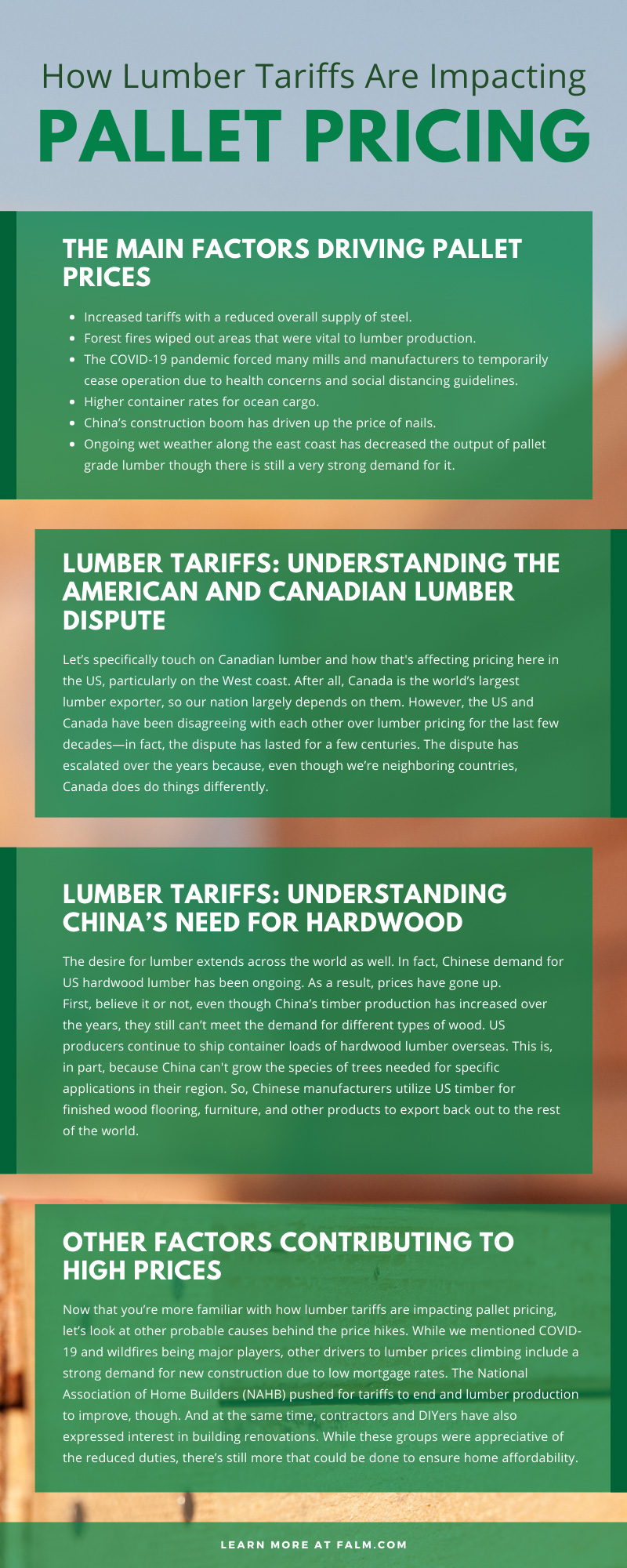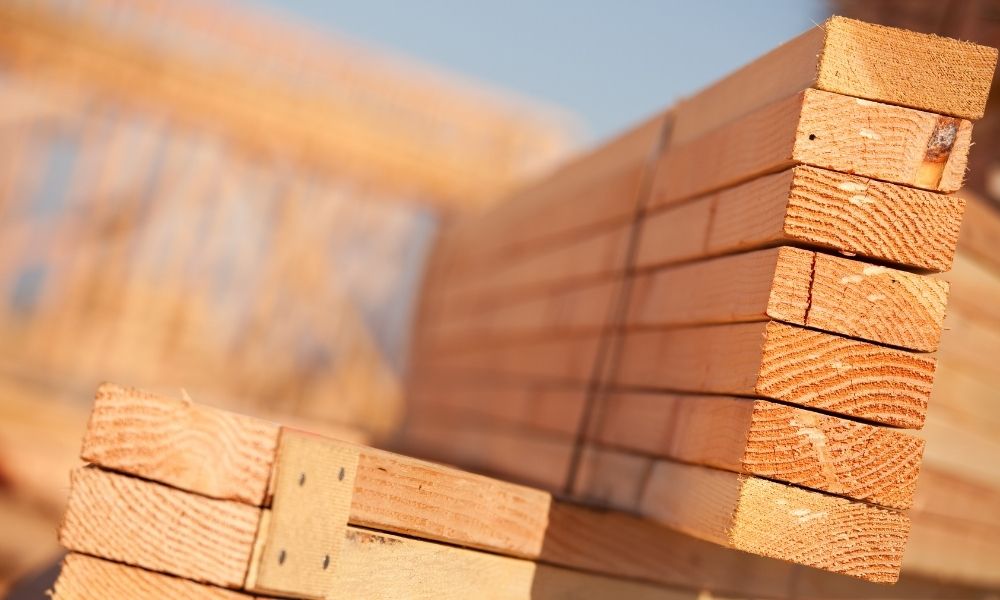- By First Alliance Logistics Management
- April 21, 2021
- Buying Pallets
Typically, a pallet’s cost is based on labor, the grade of lumber, and the type of wood it’s made from. However, the hardwood and softwood markets contribute to variability in pricing. It’s safe to say that a lot has changed within the lumber space recently. So, with all the shifts in the lumber markets this past year, we wanted to shed light on the things that could be affecting these fluctuations. We’ll particularly focus on how lumber tariffs are impacting pallet pricing. Having more background on what’s going on within the industry can aid you in planning what’s next for your company.
The Main Factors Driving Pallet Prices
- Increased tariffs with a reduced overall supply of steel.
- Forest fires wiped out areas that were vital to lumber production.
- The COVID-19 pandemic forced many mills and manufacturers to temporarily cease operation due to health concerns and social distancing guidelines.
- Higher container rates for ocean cargo.
- China’s construction boom has driven up the price of nails.
- Ongoing wet weather along the east coast has decreased the output of pallet grade lumber though there is still a very strong demand for it.
- In terms of transportation costs, the CASS Linehaul Index has risen 10.25 points since March 2020, or 8 percent. The Cass Truckload Linehaul Index is an accurate, timely indicator of market fluctuations in per-mile truckload pricing.
Lumber Tariffs: Understanding the American and Canadian Lumber Dispute
Let’s specifically touch on Canadian lumber and how that’s affecting pricing here in the US, particularly on the West coast. After all, Canada is the world’s largest lumber exporter, so our nation largely depends on them. However, the US and Canada have been disagreeing with each other over lumber pricing for the last few decades—in fact, the dispute has lasted for a few centuries. The dispute has escalated over the years because, even though we’re neighboring countries, Canada does do things differently.
For one thing, unlike the US, Canadian lumber is set administratively; in the States, prices are established through competitive marketplace pricing. Canada harvests and sells its lumber on public property, meaning they can potentially benefit from their own government subsidies. On the other hand, the US grows lumber on private properties. Canada seems to have other advantages. For example, the country is actively working to decrease deforestation, and they supposedly charge below market rates, which other nations see as unfair. While Canada’s possible subsidization was challenged in legal battles, the allegation against the Canadian government seems to be false.
The dispute recently intensified because, in 2017, the Trump administration taxed softwood lumber coming in from Canada above 20 percent. This was partly due to Trump’s America First initiative, which focused on reducing global competition and creating domestic jobs. Even though the US benefits from the increased jobs, the lumber prices also dramatically increased. Just this past year, the US Department of Commerce dropped the tax from 20 percent to 9 percent. These lower tariffs were established in an effort to maintain supply and prevent volatile pricing. But now, things are still changing given political changeover and a potential new trade agreement between Canada and the United States.
Lumber Tariffs: Understanding China’s Need for Hardwood
The desire for lumber extends across the world as well. In fact, Chinese demand for US hardwood lumber has been ongoing. As a result, prices have gone up.
First, believe it or not, even though China’s timber production has increased over the years, they still can’t meet the demand for different types of wood. US producers continue to ship container loads of hardwood lumber overseas. This is, in part, because China can’t grow the species of trees needed for specific applications in their region. So, Chinese manufacturers utilize US timber for finished wood flooring, furniture, and other products to export back out to the rest of the world. Further, due to China’s integral part in global manufacturing, they’re experiencing a construction boom. With both the increased construction and demand in the manufacturing sector, lumber availability is scarce. This desire directly contributes to pallet prices because there are limited materials to construct pallets for increased product demand.
Also, like Canada, China imposed tariffs; in 2018, Trump proposed tariffs on imported goods, and in turn, China enforced tariffs on US lumber. Due to this newly initiated trade war, we’re now part of the Phase One Trade Agreement with China, which includes their commitment to purchase US goods over the upcoming years.
Other Factors Contributing To High Prices
Now that you’re more familiar with how lumber tariffs are impacting pallet pricing, let’s look at other probable causes behind the price hikes. While we mentioned COVID-19 and wildfires being major players, other drivers to lumber prices climbing include a strong demand for new construction due to low mortgage rates. The National Association of Home Builders (NAHB) pushed for tariffs to end and lumber production to improve, though. And at the same time, contractors and DIYers have also expressed interest in building renovations. While these groups were appreciative of the reduced duties, there’s still more that could be done to ensure home affordability.
Similarly, because of the pandemic and increased time at home, more people want to invest in furniture pieces, which are often shipped on wooden pallets. Additionally, while we mentioned environmental circumstances—such as forest fires—having a large impact, severe storms have done some damage as well. Some regions have also experienced rainy seasons that slow down lumber harvesting.
How Can We Navigate These High Prices?
While these conditions are (thankfully) temporary, prices are still at an all-time high. Though prices have lowered compared to the beginning of the pandemic, prices remain above what they once were. Plus, demand is still high, even though available lumber is low at the moment. Sawmills are gradually producing, but we need immediate results from increased output. Until mills catch up with demand, however, we must navigate how to obtain lumber strategically. If your organization needs pallets, FALM is currently shipping pallets from outlaying markets into regions that are experiencing pallet shortages.
Further, the higher the prices of fresh lumber become, the more expensive it is to purchase new pallets. Fortunately, FALM can help you during these times; we can create new pallets according to your specifications. Our team will ensure you receive products that are suitable for your operations at the best possible price.
On the same hand, we provide used and recycled pallets across the United States. For over two decades, we’ve proven to our customers that we lead in the industry. We meet demand, and we even complete daily deliveries. When you buy recycled pallets, our environment benefits, and you save money. For additional information about our recycled inventory, contact us today. We’d be happy to answer any questions you may have about how you can provide your organization with the best pallets possible.


